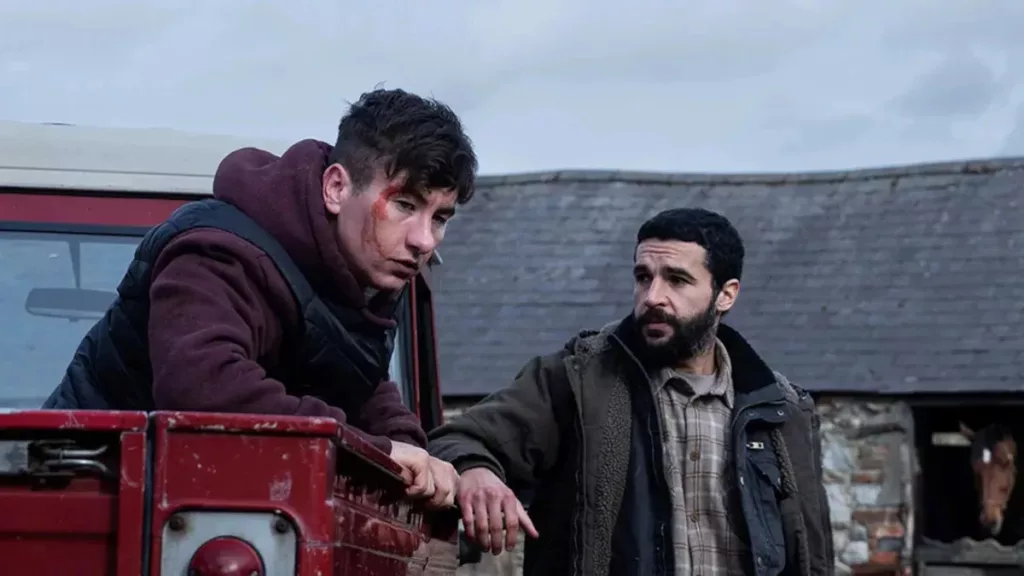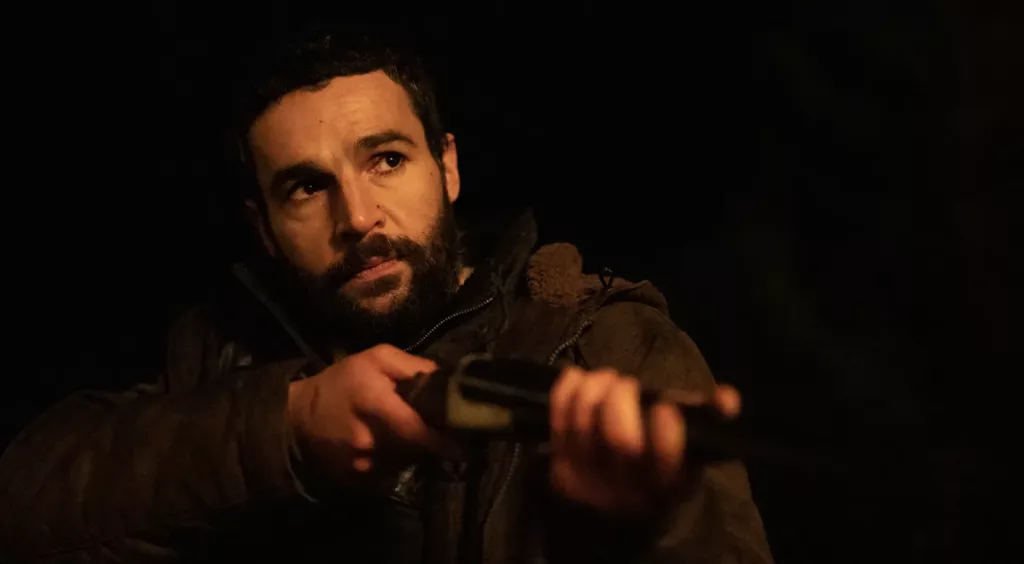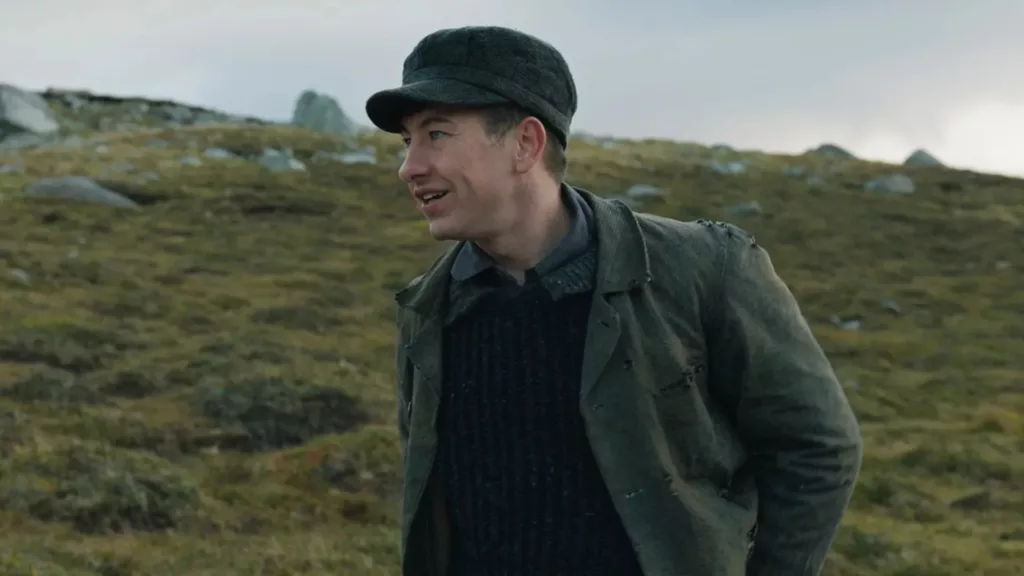Bring Them Down, the feature debut of writer-director Christopher Andrews, takes us to the isolated hills of western Ireland. Here, generations of abuse and quarrels between two farming families have curdled into an unending cycle of bloody retribution. Christopher Abbott and Barry Keoghan lead a superb cast of characters trapped within this grim orbit of violence.
The film opened last year at the Toronto International Film Festival, introducing audiences to the hardscrabble world of Michael and Jack. Played brilliantly by Abbott and Keoghan, these solitary shepherds live side by side yet remain bitterly divided by past wounds that will not heal. A dispute over stray sheep soon descends into a shocking display of cruelty, with Michael and Jack dragging their families and community deeper into despair.
Through spellbinding performances and haunting visceral filmmaking, Andrews shines a light on darkness few would dare confront. He grapples with the roots of damage within families and how old scars fester when left to rot. Bring Them Down compelled this viewer not through sensationalism but empathy—we feel the full tragedy of lives diminished by retaliation’s grip. Its bleak beauty lies in affirming our shared humanity, even in humanity’s darkest places.
The slow burn of revenge
Brooding tales of vengeance often erupt in a blaze, but Bring Them Down sees conflict ignited by sparks. It begins when sheep belonging to Michael go missing, presumed stolen by his neighbor Jack. Though neighbors, these men remain at odds due to events long past.
We learn Michael’s anger stems from a car crash years ago. Grieving the loss of his mother, he withdrew into silence while his loved ones drifted apart. Now solitary, he tends livestock with his disabled father amid rolling hills. Yet paradise masks pain, as the accident’s roots in domestic violence go unspoken.
Jack grew up hearing of Michael’s role in that faithful while weathering troubles of his own. Under his drunkard father’s thumb, the young man finds fleeting escape through rash behavior. Still, a thoughtful soul lurks beneath, empathizing with the traumas that twist adults.
When the missing sheep are sighted for sale, long-simmering resentments flare. But where some fetch vengeance in fists, Michael and Jack’s conflict takes a slower, subtler path to destruction. Simple disputes over boundaries escalate through stubborn pride until a cycle of cruel payback ensnares both.
That Bring Them Down avoids speedy climaxes, making its message haunting. Time drags for those shackled to past wrongs, each slight nurturing hatred that thrives unseen. Only through confronting old demons can its men escape this purgatory of their own making. Until then, violence will bloom from seeds planted long ago in moments of despair.
Capturing Grim Beauty in Rural Strife
Christopher Andrews understandably wanted only bleak skies and rain-swept valleys for Bring Them Down. Yet within this dour landscape blossoms visual poetry that pulls us into the cast’s hardship.
Partly this stems from anchoring viewpoints tightly to Michael. We feel terrain through his eyes, witnessing long days toiling on soggy hills. But cinematography goes further, elevating nature itself as a mirror of mood.
Windswept scrub and crags loom bitterly under lowering clouds, intensifying the men’s solitary toil. Strange beauty emerges too, like light piercing fog to illuminate a lone tree’s silhouetted branches. These glimpses gild hardship without sugarcoating its hardness.
We also live their world more fully through authentic touches. Observing sheep herding tasks portrayed seamlessly deepens our empathy. We understand these characters through skills that tie them irrevocably to this unwelcoming earth.
Yet skies darkening to unleash storms signifies not merely weather but inner demons gathering force. Landscapes reflect how turmoil has sunk roots deep here and corrupted lives completely. Visually, Bring Them Down triumphs in capturing nature’s passive endurance of humanity, for better and worse. Through visual poetry and unvarnished realism, it crafts a singular sense of place that subsumes us in its characters’ bleak orbit. No wonder viewers feel windswept away.
Carrying the Weight of Truth
Anchoring a bleak tale is no small task, yet Christopher Abbott shoulders it masterfully as Michael. Commanding our empathy from the start, he reveals his character’s inner struggles through a guarded stare and quiet action.
Glimpses of hope glint in Michael’s eyes too, before rage and regret dim their light once more. Abbott makes us feel the man beneath layers of dried sheep’s blood and misery. His nuanced turn brings depth to a difficult role, leaving us pondering Michael’s fleeting moments of peace.
Alongside, Barry Keoghan delves deeper still as Jack. Where others see an “antagonist,” this actor unveils a sensitive soul warped by trauma. Watching Jack’s face twist in pain or anger is breathtaking. Keoghan makes us care for both sides of this feud through his gift for laying bare raw emotions.
Together, these powerhouse performers resurrect humanity from characters that could have been mere archetypes. Their intimate portrayals elevate Bring Them Down above the bleak. Though the film deals in human darkness, these actors find strands of light to inspire our compassion.
Supporting cast bring equal talent. Colm Meaney instills Ray with bluster, masking deep loss, while Nora-Jane Noone makes Caroline a study in survival despite scars that never fade. All lend credible empathy to lives lived sharply on Ireland’s edge.
In stars that shine brightest when spotlighting others’ truths, Bring Them Down finds an emotional anchor. Through subtle artistry, Abbott and Keoghan resurrect our faith in humanity even amid the harshest of tales.
Into the Woods: How Trauma Takes Root
Bring Them Down delivers brutal honesty about pain that passes through generations. It explores how abuse transforms people and how violence spawns yet more violence until wrongs of the past choke out the present.
The film shows such damage, crippling its characters and community. Characters lash out due to sorrows long carried alone, festering in isolation. Their agony emerges not by choice but by pressures inflicted since youth, which twist souls until all that remains is lashing out.
Its unflinching stares into cruelty acknowledge hurtful reality. Depicting violence in its ugliness mirrors characters’ lack of hope, their empathy numbed by merciless seasons. Even butchered sheep symbolize the flesh such cruelty leaves behind.
These harrowing images reflect societal woes refusing to heal. By depicting a cycle where domestic terrors transmit like inherited disease, maybe we can break that chain. When taboos around abuse dissolve in honest storytelling, perhaps survivors feel less alone in speaking out.
Bring Them Down burrows past surface trauma into roots nourished by silence. It suggests peace will come not by ignoring scars but by braving open wounds, finding strength in solidarity against isolation’s poison. Only by uprooting excuses that enable intergenerational damage stand we a chance of planting compassion in their place. In shining a light on darkness few dare face, it offers glimmers of breaking that cycle at last.
Faces of Misery and Hope
Bring Them Down plumbs great depths of human despair yet lifts viewers with magnetic performances that breathe life into downtrodden souls. Christopher Abbott and Barry Keoghan imbue sharecroppers’ hardship with hidden wells of empathy.
While the thriller revels in bleakness, its actors ensure stagnant bloodletting doesn’t numb audiences. They gift shreds of optimism to characters faced only with inflicting or suffering cruelty. Through these artists’ artistry, viewports into tortured psyches keep observation engrossing rather than exhausting.
Yet by the story’s end, some yearn for glimmers of light to linger, not flicker out amid repetitious mayhem. One hopes character studies uncovered more nuanced resolution than mutual destruction. With emotional stakes raised so harrowingly, greater catharsis felt warranted for the horrors faced.
Still, means of expressing how cycles of violence-beget-violence strangle society remained worthy of examination. Perhaps further exploring invisible wounds’ roots could have balanced bleakness with solace. Yet films rarely answer all questions, and some haunt longest. Overall, Bring Them Down compels through authenticity hard to dismiss.
No Respite from Wounds of the Past
In its bleak beauty, Bring Them Down haunts by affirming humanity’s capacity for cruelty but also empathy. Though the relentless depiction of suffering risks trivializing pain, the film avoids this by anchoring tragedy in emotional truth.
Christopher Abbott and Barry Keoghan imbue characters burdened by misery beyond their years with hidden wells of compassion. Their nuanced work prevents characters from becoming mere archetypes, instead breathing fragile hopes we root to see blossom.
While some claim its misery relentless without catharsis, in showing intergenerational wounds’ grip, perhaps the director aims to stir our will to break that cycle. For in facing darkness few dare confront, maybe we find light to heal what festers in isolation.
This debut shines through authenticity, harsh to dismiss. It sparks dialogue on domestic tyranny and violence that strangle society. Ultimately, Bring Them Down challenges us to empathize with lives diminished by retaliation’s grip, affirming shared propensity for both hatred and redemption even in humanity’s darkest of tales. For that reason, its impact lingers, and though no reprieve comes for wounds of the past, it forces us to finally glimpse.
The Review
Bring Them Down
Bring Them Down burrows past surface trauma to reveal misery's root causes with uncompromising authenticity. Christopher Andrews' directorial debut demands viewers face stark realities yet kindles hope from even the bleakest of ashes through searing lead performances. While its bleak tone risks numbing, the film offers an unflinching mirror that stays with you long after. Ultimately it succeeds in humanizing lives reduced to darkness through shared capacity for both violence and redemption.
PROS
- Authentic and grounded portrayal of its rural Irish setting
- Nuanced and compelling lead performances by Abbott and Keoghan
- Explores heavy themes of multi-generational trauma and violence
- Achieves bleak tone without resorting to sensationalism
- Authentic regional dialects and cultural details
CONS
- Relentlessly grim storyline risks emotional fatigue
- Plot repetitiveness undercuts earlier suspenseful elements
- Fails to provide therapeutic catharsis for characters' suffering
- Minimal character development beyond motifs of anger and pain
- Tone of hopelessness may turn away more mainstream audiences






















































Discussion about this post